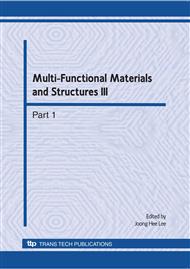p.819
p.823
p.827
p.831
p.835
p.839
p.843
p.847
p.851
Nondestructive Evaluation of Braided Carbon Fiber Composites Using High Tc SQUID
Abstract:
Braided carbon fiber reinforced plastics (CFRP) is one of the multifunctional materials for applications to industrial products. We applied the superconducting quantum interference devise (SQUID) nondestructive evaluation (NDE) technique with high magnetic sensitivity and spatial resolution to inspect the state of the fabric in the braided CFRP. We prepared flat braided CFRP samples with nonuniform, uniform and cut-out bundles, which were fabricated with fold biaxial (±45º) tubular fabric and epoxy resin. While injecting ac current into each sample, the diagonal magnetic field gradients dBz/dx and dBz/dy above each sample were measured by the NDE system employing a SQUID gradiometer and xy-scanning stage, and then, the current flow in each sample was visualized by the field-gradient-to-current conversion method. In the measurements, it was shown that the current flowed along the continuous bundles in the cases of nonuniform and uniform samples, and it transmitted between bundles in the case of the sample with cut-out bundles. From these results, we showed the possibility that the NDE method can be applied to the nondestructive inspection of the integrity of the textile of braided CFRP.
Info:
Periodical:
Pages:
835-838
Citation:
Online since:
August 2010
Keywords:
Price:
Сopyright:
© 2010 Trans Tech Publications Ltd. All Rights Reserved
Share:
Citation:


